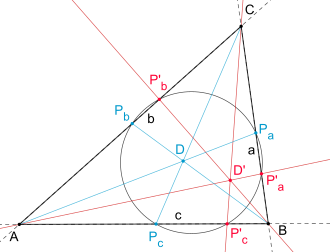Olry Terquem (mathematician)
Olry Terquem (born June 16, 1782 in Metz ; May 6, 1862 in Paris ) was a French mathematician and Jewish theologian and reformer.
biography
Terquem studied at the École Polytechnique from 1801 , as did two of his sons later. After graduation he was a tutor at the École Polytechnique and in 1804 became a mathematics teacher (professor) at the Lycée in Mainz and taught at the artillery school there from 1811 . After the end of Napoleon's rule, he returned to France in 1814 and became a professor at the central artillery depot in Paris. There he was also a librarian from 1821 to 1826. In 1852 he is mentioned there as a professor of applied science and was also mentioned when he died.
Terquem was very learned and knew foreign languages. He wrote textbooks on geometry, mechanics and algebra, published on ballistics (including translations by Charles Hutton from English), astronomy (translation of a book by Johann Franz Encke on perturbation theory, there are also comments on the monograph on celestial mechanics by him as a manuscript Pierre Simon de Laplace ) and history of mathematics. In 1816 he published old Sanskrit writings on mathematics in the journal of the Ecole Polytechnique, which he published based on English translations, and he published a mathematical manuscript by Abraham ibn Esra in the Bibliothèque nationale. He published in the Journal de mathématiques pures et appliquées by Joseph Liouville (Liouville's Journal) and participated in the editing. From 1842 he published mainly translations there, especially from German.
In 1842 he founded the Nouvelles annales de mathématiques, Journal des candidats aux écoles Polytechnique et Normale with Camille-Christophe Gerono . This appeared until 1927.
As a mathematician, he mainly dealt with plane Euclidean geometry. He is known for his work on the Feuerbach circle (nine-point circle, the name comes from Terquem, sometimes he is also named after Terquem).
He wrote Terquem's theorem on triangular geometry (see illustration). Let ABC be the lines in a triangle , and let Cevans intersect at a point . The circle through , and determined three other intersections with the triangle sides , , . According to Terquem's theorem, these also determine cevans that intersect at a point .
In addition to his academic work, Terquem was an active proponent of radical Reform Judaism. He wrote under the pseudonym Tsarphati . He saw the study of the Talmud as an obstacle to the further development of the Jewish religion and the integration of the Jews and saw reform as a means to counter the increasing conversions to Christianity of his time. He was particularly excited by the alleged conversion of his brother Lazare on his deathbed in 1845, in the presence of his wife and her family, who had already converted. Terquem considered this to be a deception, since his brother was not only an avowed Jew all his life, but also anti-Catholic, and made this known publicly in a publication. He was one of the commentators on the Hebrew-French Bible edition of Samuel Cahen .
In 1828 he became a member and in 1852 an officer of the Legion of Honor .
He was the uncle of the geologist of the same name, Olry Terquem .
Fonts
- Lettres tsarphatiques (Lettres d'un Israélite français à ses coreligionnaires) d'Orly Terquem, publiées entre 1821 et 1825 , Bachelier 1827
literature
- Philippe-Efraïm Landau: Olry Terquem (1782–1862): régénérer les Juifs et réformer le judaïsme , Revue des études juives, Volume 160, 2001, pp. 169–187.
- Aimee Louise Kahan: Creating the Français Israélite: Olry Terquem's program for Jewish reform in nineteenth-century , Harvard University, 1995.
Web links
- Information on Olry Terquem in the database of the Bibliothèque nationale de France .
Individual evidence
- ↑ Lettre adressée à M. le président et à MM. Les membres du Consistoire du département de la Seine, by O. Terquem, au sujet du baptême conféré à son frère, le Dr L. Terquem, "in articulo mortis", Metz 1845
| personal data | |
|---|---|
| SURNAME | Terquem, Olry |
| ALTERNATIVE NAMES | Tsarphati |
| BRIEF DESCRIPTION | French mathematician and Jewish theologian |
| DATE OF BIRTH | June 16, 1782 |
| PLACE OF BIRTH | Metz |
| DATE OF DEATH | May 6, 1862 |
| Place of death | Paris |











